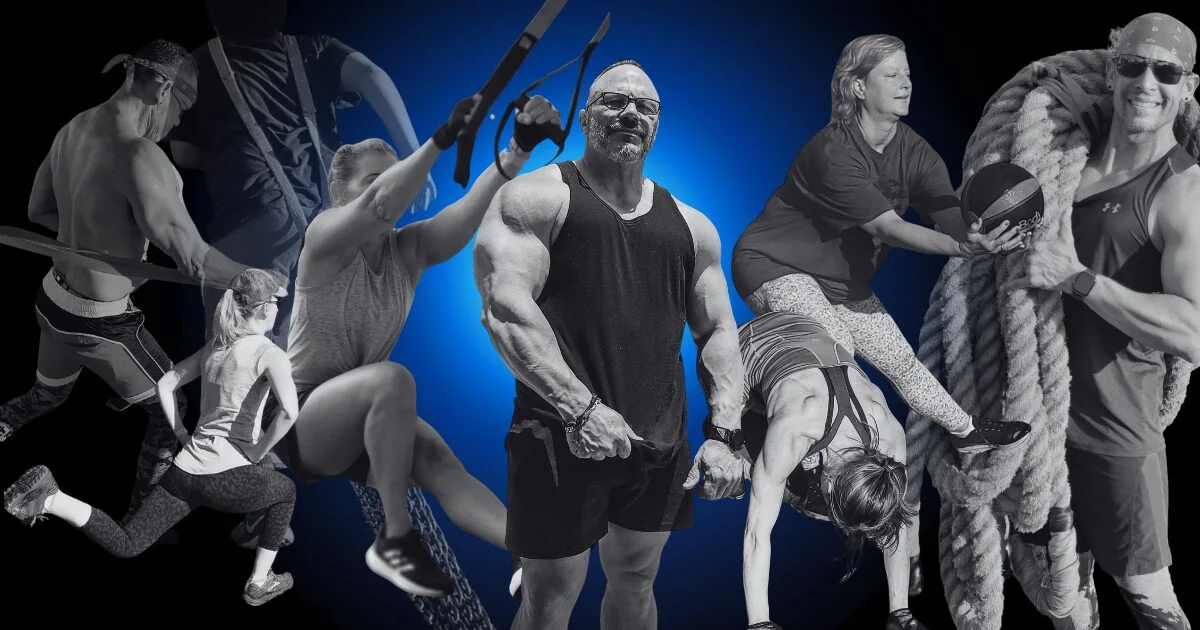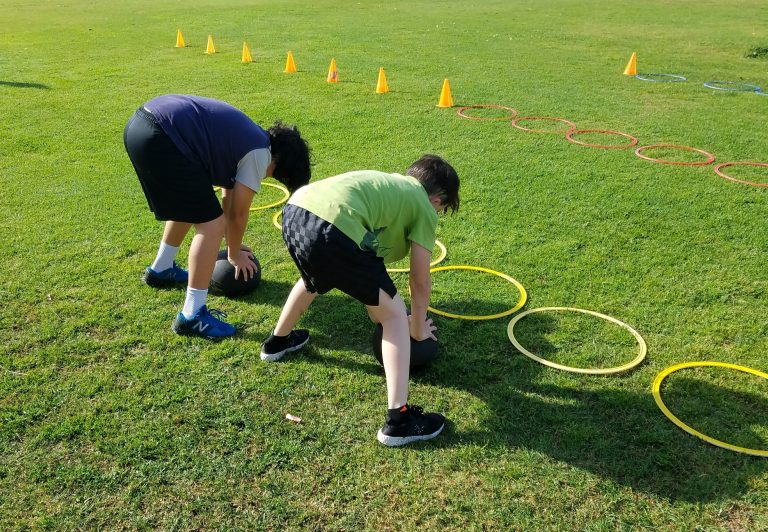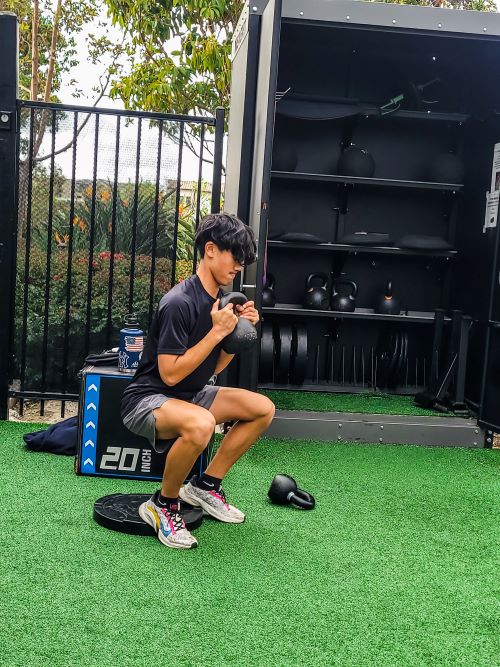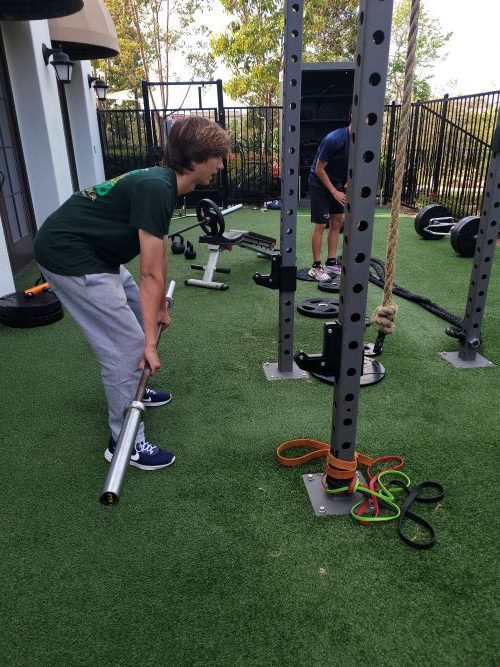
Youth Strength Training San Diego isn’t about pushing kids too hard, throwing them into unsafe “bootcamps,” or running them through random circuits. It’s about building confident, capable young humans — physically, mentally, and emotionally. At Wired Fitness SD, we help kids and teens ages 8–18 develop strength, stability, coordination, and athletic foundations in a safe, structured environment led by an expert youth strength coach.
Parents searching for teen strength training San Diego, teen athlete development, or a kids strength coach San Diego choose Wired Fitness SD because our programs focus on proper technique, healthy progressions, and long-term development. Whether your child needs movement fundamentals, sports performance, or individualized guidance through youth personal training San Diego, we provide expert coaching that supports real, lasting results.

Youth strength training isn’t miniature bodybuilding — and it’s not adult workouts scaled down. It’s a structured method of teaching kids and teens how to move with strength, control, and confidence.
At its core, proper strength training for youth includes:
🔹 Learning foundational patterns (squat, hinge, push, pull, carry)
🔹 Improving posture, balance, and stability
🔹 Correcting movement compensations
🔹 Gradually introducing resistance in a safe, controlled way
🔹 Building lifelong confidence through small, consistent wins
Kids who learn these skills early develop better athletic ability, stronger bodies, and healthier habits long into adulthood.
Strength training is one of the most important skills kids can learn — far more meaningful than random exercise or sports alone. Here’s why:
🔹 Strength improves confidence. Kids stand taller, move better, and feel more capable.
🔹 Strength reduces injuries. Correct technique and body awareness dramatically lower risk during sports and daily life.
🔹 Strength enhances sports performance. Speed, power, agility, and endurance all improve.
🔹 Strength supports mental health. Exercise improves focus, mood regulation, and emotional stability.
🔹 Strength builds long-term habits. Kids trained properly early develop a lifelong relationship with movement.
Parents consistently report:
✅ better posture
✅ improved coordination
✅ increased athletic success
✅ reduced joint aches
✅ higher motivation and self-esteem



Our programs are designed around developmental stages to meet kids and teens where they are and help them progress safely.
At this age, skill development and confidence matter most. We focus on:
🔹 Bodyweight skills and light resistance
🔹 Balance, coordination, and reflexive stability
🔹 Play-based strength challenges
🔹 Technique and movement repetition
🔹 Gradual confidence-building exposure to gym equipment
Sessions are supportive, structured, and tailored to every child’s comfort level — especially those who are shy, anxious, or new to fitness.
Teens are ready for more structure, accountability, and progressive strength training. We emphasize:
🔹 Technique-driven resistance training
🔹 Dumbbells, kettlebells, machines, and (when appropriate) barbells
🔹 Power, speed, agility, and acceleration
🔹 Mobility and joint stability
🔹 Injury prevention during sports
🔹 Movement quality over load
Whether your teen is active, athletic, or brand-new to training, we build a safe, progressive program that meets their needs.
Yes — when supervised by a qualified coach, strength training is not only safe, it’s one of the most beneficial activities for developing kids.
According to the American College of Sports Medicine (ACSM), Considering the decline of physical activity and the rise in obesity in today’s youth, it is essential to expose this population to a variety of methods to enhance compliance to physical activity., supervised youth resistance training improves strength, reduces injury risk, and supports healthy development.
The CDC also recognizes strength training as an essential component of youth physical activity guidelines.
Safe youth strength training includes:
🔹 age-appropriate progressions
🔹 technique first, resistance second
🔹 structured supervision
🔹 individualized load and volume
🔹 no maximal lifting or unsafe competition
When done correctly, it is dramatically safer than most youth sports.
If your teen plays sports, strength training is essential — and it’s the missing piece for most athletes.
We help athletes improve:
🔹 acceleration and top-end speed
🔹 vertical jump
🔹 first-step quickness
🔹 core strength and rotational power
🔹 landing mechanics
🔹 agility and multi-directional movement
🔹 conditioning without burnout
Athletes we train gain:
✅ higher performance
✅ better confidence
✅ fewer injuries
✅ improved coachability
✅ greater longevity in their sport
This is what teen athlete development should look like — purposeful, progressive, and supportive.
We proudly support autistic, ADHD, sensory-sensitive, anxious, and higher-functioning neurodiverse youth.
Our approach includes:
🔹 Predictable, structured session flow
🔹 Clear, step-by-step instruction
🔹 Positive reinforcement
🔹 Low-stimulus coaching environments
🔹 Flexible pacing depending on energy, focus, or sensory needs
🔹 1-on-1 or very small group options
Movement is powerful — and when delivered correctly, it improves regulation, self-esteem, and connection.
Most parents see noticeable changes quickly.
🔹 Skill learning
🔹 Better posture
🔹 Increased confidence
🔹 More willingness to try new movements
🔹 Strength gains
🔹 Improved coordination
🔹 Smoother technique
🔹 Less fear around equipment
🔹 Better energy + motivation
By 8–12 weeks, kids and teens look and feel completely different.
We offer multiple flexible training environments to match your family’s needs:
🔹 Mission Bay Park – outdoor strength + conditioning
🔹 Boulevard Fitness (University Heights) – gym-based strength training
🔹 In-home training – we bring the equipment to you
🔹 Small group pods (2–4 kids/teens) – siblings, friends, teammates
Regardless of location, kids receive safe coaching and structured progression from a highly experienced youth strength coach.
Give your child expert coaching that develops strength, athleticism, and lifelong confidence. Safe youth and teen strength training designed for ages 8–18.
Yes. When led by an experienced kids strength coach San Diego, strength training is one of the safest and most beneficial activities for growing bodies. We teach proper technique, start with bodyweight, and progress gradually based on age, experience, and movement competency. Research from the American Academy of Pediatrics supports youth resistance training as safe and effective when supervised properly.
Our youth personal training San Diego program starts as early as ages 8–9 with movement-based strength work. By ages 11–12, kids can safely begin light resistance training. Teens (13–18) can progress into structured teen strength training San Diego programs with machines, dumbbells, kettlebells, and—when ready—barbell fundamentals.
Strength improves speed, power, agility, balance, first-step quickness, landing mechanics, and injury resilience. Our teen athlete development sessions focus on mobility, stability, resistance training, and sport-specific demands. Athletes in football, basketball, soccer, volleyball, baseball, dance, cheer, and track see measurable improvements within 4–8 weeks.
No. This is a myth. Modern scientific research shows no negative impact on height, growth plates, or physical development. Supervised resistance training actually reduces injury risk and supports strong bone development during growth spurts.
Yes. Families often choose in-home sessions for neurodiverse youth, kids who prefer familiar environments, busy parents, or those needing private coaching. We bring dumbbells, bands, movement tools, and portable equipment to your home and tailor the session to your space.
Yes. Many of our youth clients do NOT play organized sports. Strength training helps kids with self-esteem, movement skills, posture, body awareness, and emotional wellness — even if they have no athletic background.
We use short intervals, variety, clear progressions, and positive reinforcement — not shouting or punishment. The sessions are challenging, but fun and achievable, with lots of “small wins” to keep motivation high.
Yes. We offer 2–4 youth pod sessions where siblings, friends, or teammates train together. These sessions are ideal for kids who feel more comfortable with familiar partners and can be funded by SDRC in certain cases when goals align.
Yes. We specialize in training neurodiverse kids and teens using predictable structure, low-pressure communication, clear instructions, and sessions paced around your child’s cognitive and sensory needs. Many neurodiverse youth thrive with strength training because it improves emotional regulation, proprioception, and confidence.
Strength training provides autistic youth with structure, predictability, and clear cause-and-effect outcomes, which can be calming and regulating. Repeated movement patterns improve proprioception, body awareness, and spatial understanding, helping reduce clumsiness and sensory overwhelm. Many autistic kids feel more grounded after strength training because the pressure, resistance, and rhythmic movements help regulate the nervous system. It also improves confidence, social interaction skills, and tolerance for new environments in a controlled, supportive way.
Yes. Strength training creates a consistent routine that helps stabilize mood and energy levels. The physical exertion helps reduce anxiety, while predictable structure lowers stress around transitions or new activities. Over time, kids often report feeling more “in control” of their body, which correlates with better emotional regulation and fewer behavioral spikes.
Yes — many families use SDRC funding for our 1:1 and small-group youth sessions. We can provide session documentation, structured program outlines, and coordination with your service provider if needed. If your caseworker requires a specific classification or justification, we can help prepare the supporting documentation.
We break movements into simple steps, demonstrate first, and give short, clear cues rather than long explanations. Visual modeling, hands-on guidance (only if appropriate), and repetition help build confidence without pressure. Sessions move at the child’s pace with flexible adjustments depending on focus, sensory needs, or energy fluctuations.
Yes. Many youth with sensory challenges respond very well to strength stimuli. Resistance and compression provide grounding input, while controlled movement helps desensitize or regulate sensory responses. Kids often experience improvements in balance, body position awareness, joint stability, and overall sensory integration.
Absolutely. Strength training gives kids a clear path to success, where small wins generate confidence quickly. As they master new skills, lift slightly more weight, or move with better control, they begin to believe in their abilities again. This often spills over into school, friendships, and daily activities.
Most teens do not need aggressive supplementation. The safest, most effective options are basic essentials such as creatine monohydrate, protein powder to support daily intake, and electrolytes if they train or compete frequently in heat. All supplements should be supervised by parents, aligned with the teen’s goals, and introduced only after consistent nutrition habits are established.
Yes, creatine monohydrate has extensive research supporting its safety for teens when taken at 3–5 grams per day without loading phases. It supports strength, power, lean mass development, and recovery. Creatine should be used responsibly, with adequate hydration, and introduced only after a teen demonstrates consistent training habits.
Generally, no. Most pre-workouts are stimulant-heavy and not appropriate for teens. If needed, a simple, non-stimulant supplement such as electrolytes or a small amount of citrulline may be used, but most teens perform best with proper nutrition and hydration rather than performance stimulants.
Teens need adequate protein, quality carbohydrates, and healthy fats. Most teens under-eat protein, which slows recovery and limits strength gains. Ideally, they should consume lean meats, eggs, dairy, fish, whole fruits, rice, potatoes, and whole-food carbohydrates around training. Proper hydration also plays a major role in strength, energy, and focus.
Most active teens benefit from approximately 0.8–1 gram of protein per pound of goal bodyweight. This supports muscle growth, recovery, and healthy hormonal development. Protein shakes can help fill gaps, especially for picky eaters or busy schedules.
Teens perform best when they eat protein-rich meals spaced throughout the day. Ideally, they should consume a meal with protein and carbohydrates 60–90 minutes before training and a recovery meal or shake afterward. Consistency matters more than perfection, and small improvements often create noticeable changes within a few weeks.
Yes, but it should be approached carefully. The goal is to support strength, hormonal health, and growth while reducing body fat slowly through balanced nutrition and consistent movement. Extreme calorie restriction is unsafe. Strength training combined with better food choices naturally supports healthy body composition changes.
Yes. We provide simple, realistic nutrition strategies that teens can actually follow. This includes pre- and post-workout recommendations, protein targets, hydration goals, and guidance for improving overall eating patterns without overwhelming the teen or the family.
Sometimes. The principles of strength training remain the same, but pacing, communication style, sensory environment, and structure may need to be adapted. Some autistic teens prefer repetitive, predictable movements; others thrive with variety. We tailor every program to match the teen’s individual learning style and sensory profile.
Theme: Illdy. © Copyright 2016. All Rights Reserved.
